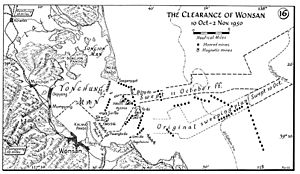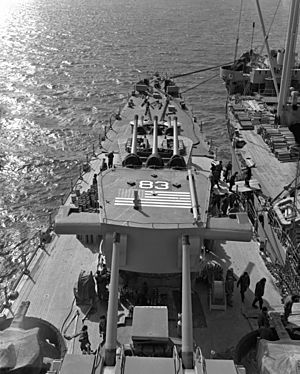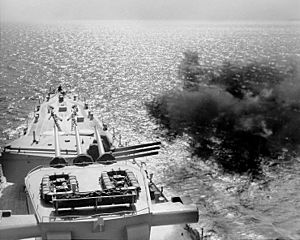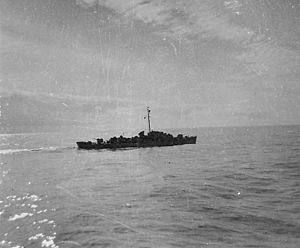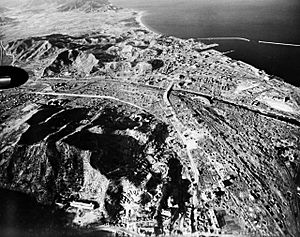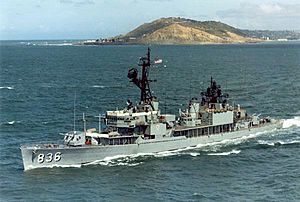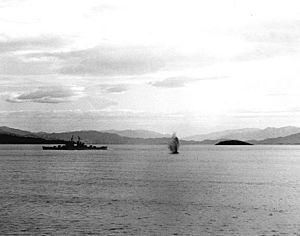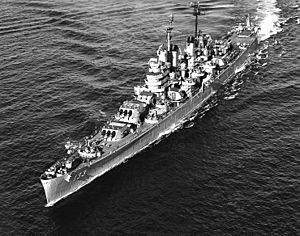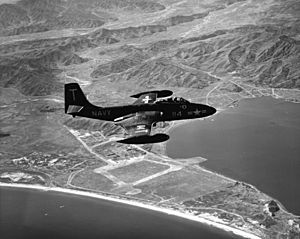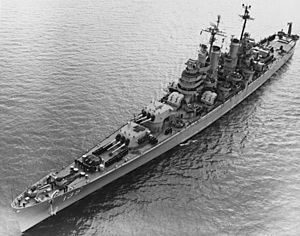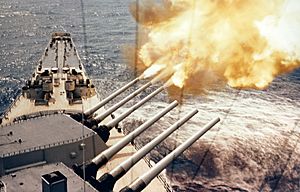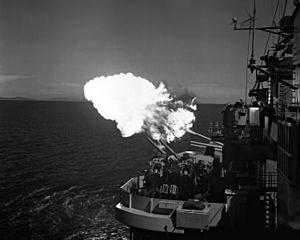Blockade of Wonsan facts for kids
Quick facts for kids Blockade of Wonsan |
|||||||
|---|---|---|---|---|---|---|---|
| Part of the Korean War | |||||||
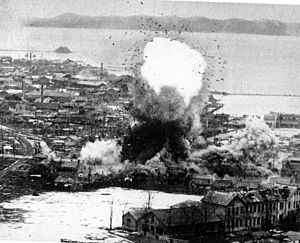 An explosion destroys North Korean supplies during the blockade of Wonsan. |
|||||||
|
|||||||
| Belligerents | |||||||
|
|||||||
| Casualties and losses | |||||||
| 41 killed 158 wounded 1 patrol boat sunk 2 minesweepers sunk 1 battleship damaged 2 cruisers damaged 16 destroyers damaged 3 frigates damaged 5 minesweepers damaged 1 ... damaged 3 LSMRs damaged |
unknown | ||||||
|
|||||||
The Blockade of Wonsan, also known as the Siege of Wonsan, was a long naval operation during the Korean War. It lasted for 861 days, from February 16, 1951, to July 27, 1953. This made it the longest naval blockade in modern history.
Forces from the United Nations, mainly the United States, stopped the important city of Wonsan from being used by the North Korean Navy. The blockade forced North Korean troops to stay away from the main battle lines. North Korean artillery (large guns) often fired at the American ships, but it usually didn't cause much damage. However, UN ships and planes heavily damaged the city of Wonsan.
Contents
Why Wonsan Was Important
A Key City in the War
Wonsan was a very important city during the Korean War. It was on North Korea's southeastern coast and had a large harbor, an airfield, and an oil refinery. The city had about 75,000 people and up to 80,000 troops, along with many large guns (artillery).
After the Battle of Inchon, General Douglas MacArthur wanted his troops to land at Wonsan. From there, they would move west to meet up with another army and then advance towards Pyongyang, North Korea's capital.
North Korea had many sea mines given by the Soviet Union and China. They used these mines to protect Wonsan. Soviet military experts also helped them create better minefields. One of the first goals for the UN was to find and destroy these mines. This required many special ships called minesweepers.
Clearing the Mines: Operation Wonsan
The operation to clear the mines, called Operation Wonsan, started on October 10, 1950. This was ten days before the planned landing. Rear Admiral James H. Doyle led Task Force 90, a group of many American warships.
Just two days later, on October 12, mines sank two minesweepers, USS Pledge and USS Pirate. Twelve sailors died, and many more were hurt. This happened while North Korean guns on shore were firing at them. The United States Navy then started building many new minesweepers, the biggest shipbuilding effort since World War II.
The Unnecessary Landing: Operation Tailboard
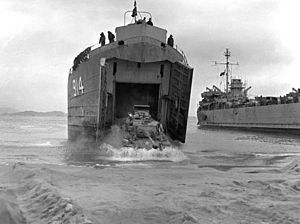
Operation Tailboard was the name for the United States Army landing at Wonsan. It turned out to be unnecessary. Thousands of marines and soldiers, over 30,000 in total, traveled over 800 miles from Inchon. They arrived off Wonsan on October 20.
However, the minefields were still being cleared. So, for five days, the troops had to wait on their ships. When they finally landed on October 25, the North Koreans had already left. British and South Korean forces were already securing the area.
General MacArthur was criticized for this. Many felt he should have used these troops to chase the retreating North Korean Army elsewhere. On October 19, the South Korean Army captured Pyongyang. So, instead of going there, the American army moved north along the coast.
Leaving Wonsan: Evacuation
UN forces did not hold Wonsan for long. After China joined the war, Allied forces were ordered to leave Wonsan on December 9, 1950. They took thousands of refugees, military personnel, vehicles, and tons of supplies with them.
General MacArthur planned to regroup in Japan before attacking again. When the North Koreans and Chinese took back the city, they made its defenses much stronger. They put down more sea mines and set up new artillery positions.
The Blockade Begins
First Fights
The blockade started on February 16, 1951, and lasted until July 1953. During this time, US Navy ships and planes often fought with shore batteries. Several American ships were hit by land-based artillery, but none were sunk.
UN Task Group 95.2 was in charge of the blockade. They first attacked Wonsan on February 17, 1951. They targeted anything used by the North Koreans, causing a lot of damage.
On February 19, the destroyer USS Ozbourn was fired upon by shore batteries. It was hit twice. The ship also rescued a pilot whose plane had been shot down.
The island of Sindo-ri in Wonsan Harbor was captured by South Korean marines on February 24. They were supported by American destroyers and frigates. On May 20, 1951, the battleship USS New Jersey fired its guns at shore targets for the first time in the war. While patrolling Wonsan, it was hit by one shell. One sailor was killed and two were wounded. The New Jersey then fired back until the enemy guns stopped. This kind of fighting continued throughout the blockade.
Operation Fireball
Operation Fireball was a plan to bombard (heavily shell) the Wonsan area from May to September. It involved both naval ships and planes from the 5th Air Force. This caused a lot of damage to North Korean forces.
On the night of May 21-22, two American LSMRs (ships that fire rockets) fired nearly 5,000 rockets in just 35 minutes. This further damaged the city's defenses. UN carrier planes used flares to light up the area while the warships fired their guns. These rocket ships caused many casualties among the North Korean troops.
The USS Walke Incident
USS Walke was a destroyer operating near Wonsan. On June 12, 1951, the Walke was hit by either a torpedo or a floating sea mine. The explosion badly damaged the ship. Twenty-six sailors were killed, and 40 others were wounded. Many were thrown into the water by the blast. This was the deadliest event for the US Navy during the Korean War.
Sailors on nearby destroyers saw an oil slick and dropped depth charges, thinking there were submarines. The Walke was temporarily repaired and sailed to Japan. Later, it was confirmed that a torpedo part was found, suggesting it was hit by a torpedo. The Walke was repaired and returned to Korea the next year.
Battle of the Buzz Saw
The Battle of the Buzz Saw was what US Navy sailors called North Korea's response to the UN attacks. After months of heavy damage, North Korea started using new weapons to try and break the blockade.
On July 6, 1951, the US launched another naval bombardment. North Korea responded with a very heavy attack on July 17. For over four hours, three American destroyers fired thousands of shells at Wonsan. The North Koreans fired back strongly, but the American ships were not seriously damaged.
Operation Kickoff
From late June to August 1951, North Korean attacks on American ships increased. So, the United States focused on destroying enemy gun positions. On July 3, the frigate USS Everett was hit, killing one sailor and wounding seven.
The Americans responded with a large attack by carrier planes. In one day, 247 bombing missions were flown against Wonsan. South Korean marines also raided the mainland from Cho-do island.
Operation Kickoff involved ships sailing slowly into Wonsan Harbor every day to bombard known enemy positions. On the first day, two LSMRs were hit and damaged. Other ships, including the battleship New Jersey, also took part.
On August 4, British Royal Marines set up mortars on Hwangto-do island to fight the North Korean shore batteries. On August 11, the minesweeper USS Dextrous was hit twice, killing one sailor and wounding three. Operation Kickoff was successful in reducing attacks for a while.
More Mine Clearing Operations
North Koreans kept laying mines near Wonsan and Hungnam. So, in September, UN forces began sweeping the coastline again. This allowed UN ships to stay closer to shore. On September 8, the destroyer escort USS William Seiverling was hit three times by shore artillery. Its engine room flooded, but no one was hurt.
Minesweepers like Redstart and Heron were also damaged by shell fire. On September 24, a South Korean frigate, ROKN PF-62, was hit three times and caught fire. Three South Korean sailors were wounded, but they saved their ship. Mine clearing continued for months, and attacks on UN ships became less common.
Fighting Gets More Intense
In late 1951 and 1952, the UN learned that North Korea was building more minelaying boats and planning attacks on islands around Wonsan. MiG fighter planes also started appearing more often, threatening UN aircraft and ships. North Korean troops, supplied by the Soviets and Chinese, also fired many artillery shells.
Shore batteries became more accurate, using better aiming equipment. With most of the mine clearing done, American ships started shelling the city again. The battleship New Jersey attacked Wonsan and other coastal targets from November 1-6, 1951. It targeted the oil refinery, trains, bridges, and troop areas.
On December 20, the battleship USS Wisconsin took part in another large bombardment of Wonsan. Six days later, a South Korean ship was lost, likely hitting a mine.
On January 11, 1952, two minesweepers, Redstart and Dextrous, were hit by accurate battery fire. Dextrous was badly damaged, and one sailor was killed. Other destroyers also fought long duels with North Korean guns.
By the one-year anniversary of the blockade, Wonsan was bombed daily. On February 16, 1952, the blockade's anniversary, three destroyers attacked Wonsan. On March 13, UN ships and planes silenced enemy guns at Kalmagak.
April 1952 Battles
In April 1952, fighting continued. On April 1, the destroyer USS Leonard F. Mason had an explosion in its depth charge locker but no one was hurt. Other ships also faced enemy fire but were not damaged.
On April 10, the cruiser USS Saint Paul and destroyer USS Hanson attacked Wonsan. Another ship, USS Silverstein, was fired upon, but the shells landed far away. This showed that North Koreans were getting better at aiming.
On April 29, the USS Cabildo was hit, causing minor damage and wounding two sailors. On the same day, USS Silverstein and USS Maddox were covering South Korean boats when enemy batteries opened fire. The American ships fired back and suppressed the guns. Planes from the USS Valley Forge also provided air support.
Throughout May 1952, ships like USS Maddox and USS Laffey attacked North Korean railroad targets. Hidden guns made it hard to find the enemy, but three enemy gun positions were destroyed. On May 8, the USS Samuel N. Moore|DD-747|6}} was hit by a shell, but it caused no major damage.
On May 29-30, several ships, including USS Ozbourn and USS Radford, were fired upon. The USS Heron was hit by machine gun fire. No UN sailors were hurt, and the ships always fired back.
On June 7, North Korean artillery bombarded Hwangto-do island. On June 19, the USS Parks|DE-165|6}} caught 300 enemy troops repairing a railroad. It fired at them, causing many casualties and hitting a railroad bridge.
On August 10, 1952, enemy guns fired about 250 shells at USS Barton and USS Jarvis. The Barton was slightly damaged, and one sailor was killed and one wounded. Two days later, USS Grapple was hit once below the waterline.
Typhoon Karen
Typhoon Karen hit Korean waters, stopping blockade activities. Several UN warships were damaged by the storm. The North Koreans used this chance to attack Hwangto-do island again. After the typhoon, the USS Lewis|DE-535|6}} fired at an enemy battery, silencing it.
On September 15, the Barton hit what was thought to be a floating mine. Five sailors went missing and were presumed dead, and six others were wounded. The ship was damaged but made it to port.
On September 19, the USS Alfred A. Cunningham was hit five times by enemy guns. Eight American sailors were wounded, but none fatally. The ship was damaged but could still fire back.
On September 23, the battleship USS Iowa was attacked, but its large 16-inch guns quickly silenced the enemy.
North Korean Air Attack
On October 7, the first and only naval air battle at Wonsan happened. MiG-15s attacked UN planes. There was no damage or casualties in most of these fights, but one MiG-15 destroyed a US F4U plane near Hungnam.
On October 16, the USS Toledo|CA-133|6}} was shot at, but the shells landed far away. The USS Mansfield|DD-728|6}} was also attacked. On November 20, the USS Thompson was hit by a shell, wounding one sailor and causing minor damage.
On October 21, the USS Lewis was hit by two shells while helping South Korean minesweepers. One shell caused minor damage. The other went through the hull and caused a steam explosion, instantly killing six sailors and fatally injuring a seventh. The Lewis continued to fight and make smoke before heading to Japan for repairs.
On November 25, the Thompson was attacked by enemy jets, which dropped explosives nearby. On December 11, small minesweepers were forced to use smoke to hide from enemy fire. The USS Waxbill and USS Marshall collided, causing minor damage to the Waxbill.
Peak of the Fighting
January 2, 1953, marked the start of a huge North Korean bombardment of UN-held islands in Wonsan Harbor. For months, enemy guns fired hundreds of shells at Hwangto-do and Yo-do islands. This operation failed, as most shells targeted the islands instead of the blockading fleet. Only four UN personnel were killed and fifteen wounded during these bombardments. UN ships constantly fired back.
On February 9-10, American naval aircraft launched a massive attack on North Korean supply lines and transport targets. This caused huge damage to the enemy's logistics. On February 14, enemy shells killed two men, including an American marine, and wounded nine others. This was the most successful North Korean artillery attack against UN ground forces.
On March 5, the battleship USS Missouri was challenged by five shells while bombarding Wonsan. The Missouri was not hit and quickly silenced the battery. Five days later, the Missouri received fifteen more shells but again escaped damage.
On March 18, 1953, the cruiser USS Los Angeles was hit by one enemy shell, but the damage was light, and no one was hurt. On April 2, the USS Los Angeles was hit again, causing minor damage to its mainmast and injuring thirteen men.
On April 16, the USS Maddox was hit by one shell out of 156 fired at it. The shell caused a hole and wounded three sailors. On April 19, the USS James E. Kyes was hit by a large shell, tearing a three-foot hole and wounding four men.
North Korean Bombardment of UN Islands
The North Korean bombardment of UN-held islands continued daily in April 1953. The USS Manchester was slightly damaged. On April 23, five marines were wounded on Tee-do island.
On April 29, a helicopter on a mine reconnaissance flight was fired upon. This showed Americans that North Korea was using a new type of weapon. The US Navy reported that April 1953 was the peak of the three-year battle. North Koreans fired over 2,000 artillery rounds at the blockade and over 1,000 more at the islands.
Mine warfare also increased. After months of finding nothing, 32 new mines were found in Wonsan Harbor. On May 2, hidden guns hit the USS Maddox and USS Owen, causing slight damage but no casualties. The USS Bremerton|CA-130|6}} also engaged enemy batteries, and two men received minor wounds.
Allied Air Strike against Yo-do Island
On May 15, UN planes attacked an airfield on Yo-do island while American ships silenced batteries. The USS Brush was hit, making its gun inoperable, and nine sailors were wounded. The battleship New Jersey was fired at on May 27 but quickly silenced the enemy.
On June 4, the USS LSMR-409 was hit, causing moderate damage and wounding five men. The enemy fired 30 shells before being silenced by over 200 rockets from the LSMR.
On June 11, the USS Wiltsie was hit once, causing a four-inch hole in the deck, but no casualties. On June 17, destroyers in Wonsan Harbor faced concentrated fire. The USS Irwin and USS Rowan were hit the next day. The Irwin had a three-foot hole and five wounded sailors. The Rowan suffered five hits and ten wounded.
On July 7, North Korean gunners fired over 300 shells at the USS Lofberg, USS Thomason, and USS Hamner. The Thomason suffered holes and dents, but no casualties. The Americans fired back with 880 rounds.
A few days later, North Korean artillery hit the USS Saint Paul, damaging two guns but injuring no one. The North Koreans then focused on attacking UN islands. On July 23, the Saint Paul drew 12 shells, all missing. On July 27, the USS Saint Paul fired the last American shots of the battle. With the signing of an armistice (peace agreement), the fighting ended after 861 days.
What Happened Next
UN ships at Wonsan achieved a major goal by blockading enemy territory for so long. UN naval forces caused heavy losses to the North Koreans while suffering relatively few casualties themselves. The North Korean artillerymen defending Wonsan were mostly ineffective, wasting many shells. Wonsan was destroyed and remained so for years after the war. However, because of its important location, it was eventually rebuilt.
See also
- List of US Navy ships sunk or damaged in action during the Korean War
Images for kids


